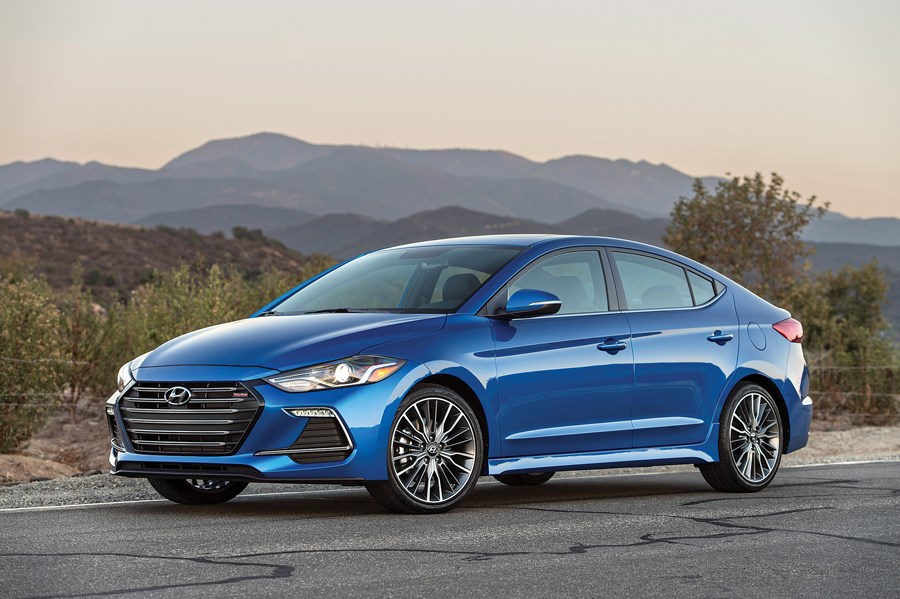If it seems strange to be getting excited about driving a Hyundai, get used to it.
The Koreans set their pace years ago with the zippy little Tiburon, followed it up with the genuinely quick Genesis Coupe, and are now taking the fight to the sport compact segment with the Sport version of the Elantra.
The Elantra is already a handsome little car, and drives with a certain amount of zip. What’s missing from the formula is a willing engine: the base 2.0-litre inline four makes 147 horsepower, reasonable for the segment, but the chassis feels like it could take more.
Enter the Elantra Sport, Hyundai’s answer to cars like the Nismo Sentra and the upcoming Honda Civic Si. Hyundai’s added some turbocharged flavour to their compact sedan, and then topped it off with specialized suspension tuning and a few exterior upgrades.
Mind you, every manufacturer these days has much the same idea. Turbocharging is widespread, and dialing up a firmer suspension and some go-fast looks is easy to do. It’s also easy to get wrong.
The question becomes: has Hyundai simply mailed it in, or have they managed to make something exciting?
Design
Hyundai’s styling remains a bright spot in an industry where extreme aggression reigns supreme. Instead of floating roofs and spindle-shaped grilles, we get sharply European styling and a reserved-but-tweaked appearance.
The Sport has bigger side air intakes than the standard Elantra, but aside from the front it’s just as reserved as a Golf GTI. The standard 18-inch multi-spoke alloys add just the right amount of visual heft to the side profile, and the twin-tip rear exhaust looks relatively muted.
If you start looking at what Honda’s done to the standard Civic, the Elantra Sport is a model of restraint, and that’s a good thing. Luckily, there’s a little more going on underneath the sheetmetal.
Environment
Fitted with nicely bolstered seats that should still be comfortable for the daily commute, the Elantra Sport’s interior is a welcoming place to be. Again, it’s slightly Germanic in layout, as if Hyundai is cribbing a few details from VW.
For the most part, that’s a good thing, with a plain-but-smart cabin and a few sporty features like a flat-bottomed steering wheel and aluminium pedals. The rear seats offer plenty of space, and the trunk is a useful 407 litres.
The basic touchscreen interface on this particular Elantra Sport was easy to navigate. If you’d like a little more punch to the stereo, the optional Tech package adds an Infinity eight-speaker system and touchscreen navigation. It’s an extra $2,500, but seems worth the price.
Performance
With a 1.6-litre turbocharged four-cylinder cranking out 201 h.p., the Elantra Sport provides just enough gumption to be interesting to drive, yet balanced. Peak power comes at 6,000 r.p.m., with peak torque of 195 foot-pounds at 4,500 r.p.m.
Down low grunt is good, and the turbocharged engine activates early. A dual-clutch seven-speed transmission is on offer, but happily this week’s tester came with a rarity: a genuine six-speed manual. Shifts were light and the clutch could have a little more feel, but the Elantra Sport was very easy to drive.
Better yet, the chassis of this car hasn’t quite reached its potential. A new multi-link rear suspension replaces the twist-beam of the basic Elantra, and is a little more agile over rough surfaces. Better yet, the suspension manages to be tauter than the standard Elantra without making the ride too stiff for the average consumer.
The steering is also greatly improved. It still lacks ultimate feel, something that most electrically-assisted racks suffer from, but it does have more weight and a quicker ratio. A tide of snowy, slushy weather highlighted the Elantra’s slightly numb steering, but the little car plowed through the poor weather with ease.
And, taken as a whole, it’s quite good fun. There will be sportier offerings in this segment, especially as Honda readies the new, turbocharged Civic Si, but the Elantra Sport provides a nice blend between driving fun and sensible practicality.
Features
Speaking of numb hands on the steering wheel, it’s worth noting that a heated steering wheel is standard on the Elantra Sport, as are heated seats. A six-speaker stereo is also standard, as is a blind spot monitoring system, projector headlights, and a proximity key.
Basically, even the base Elantra Sport is very well equipped for its $24,999 starting price. It’s a sporty choice, but again a practical one.
Fuel economy is pretty good for a zippy little car like this, with the caveat that the gentler you drive, the better your real world results will be. Official figures for the manual are 10.7 (litres/100 kilometres) in the city and 7.8 on the highway, with the dual-clutch netting 8.9 city and 7.0 on the highway.
Green light
Nicely styled; zippy engine; smartly trimmed cabin; lots of features for the price.
Stop sign
Sporty but not quite a full performance offering; steering is still a little numb.
The checkered flag
Fun, practical, and good value. You can have your Hyundai cake and eat it too.
Competition
Nissan Sentra Nismo ($TBD): Another feature-laden sporty compact, the Nismo variant of the Sentra joins the 370Z and the mighty GT-R in offering maximum performance to Nissan fans. In the case of the Sentra, that means a 188 h.p. 1.6-litre turbocharged engine, similar to the one you get in the Juke.
Slightly roomier than the Elantra, the standard Sentra is also a very soft car – Nissan will have their work cut out for them trying to make this economy-minded machine into a legitimate performer. When it hits the road early next year, it’ll have to work hard to beat the Elantra Sport.



